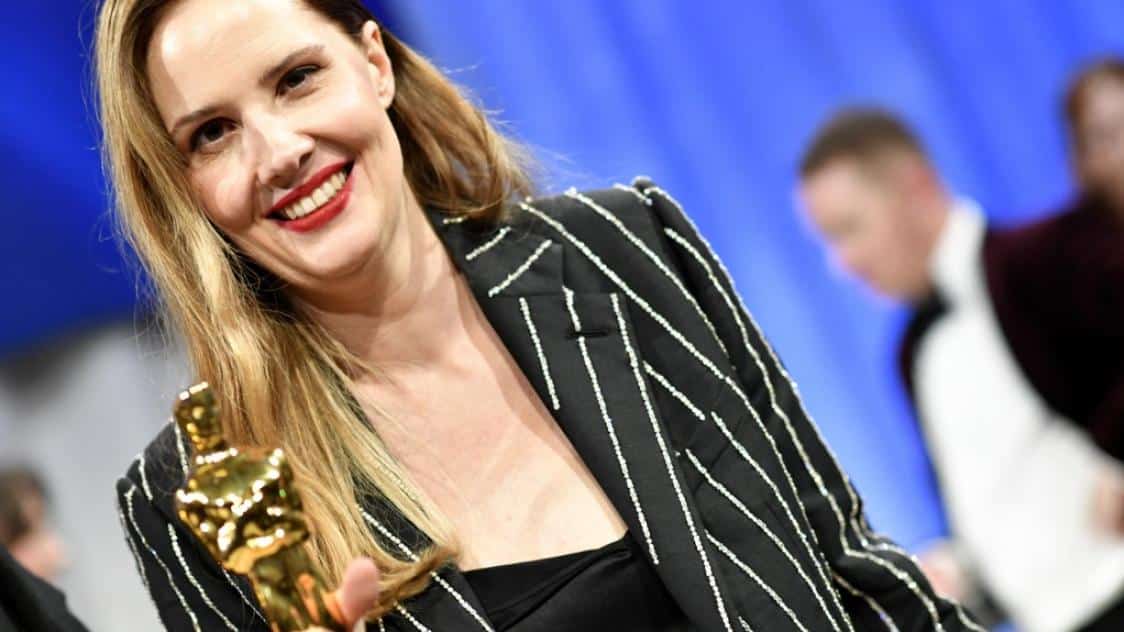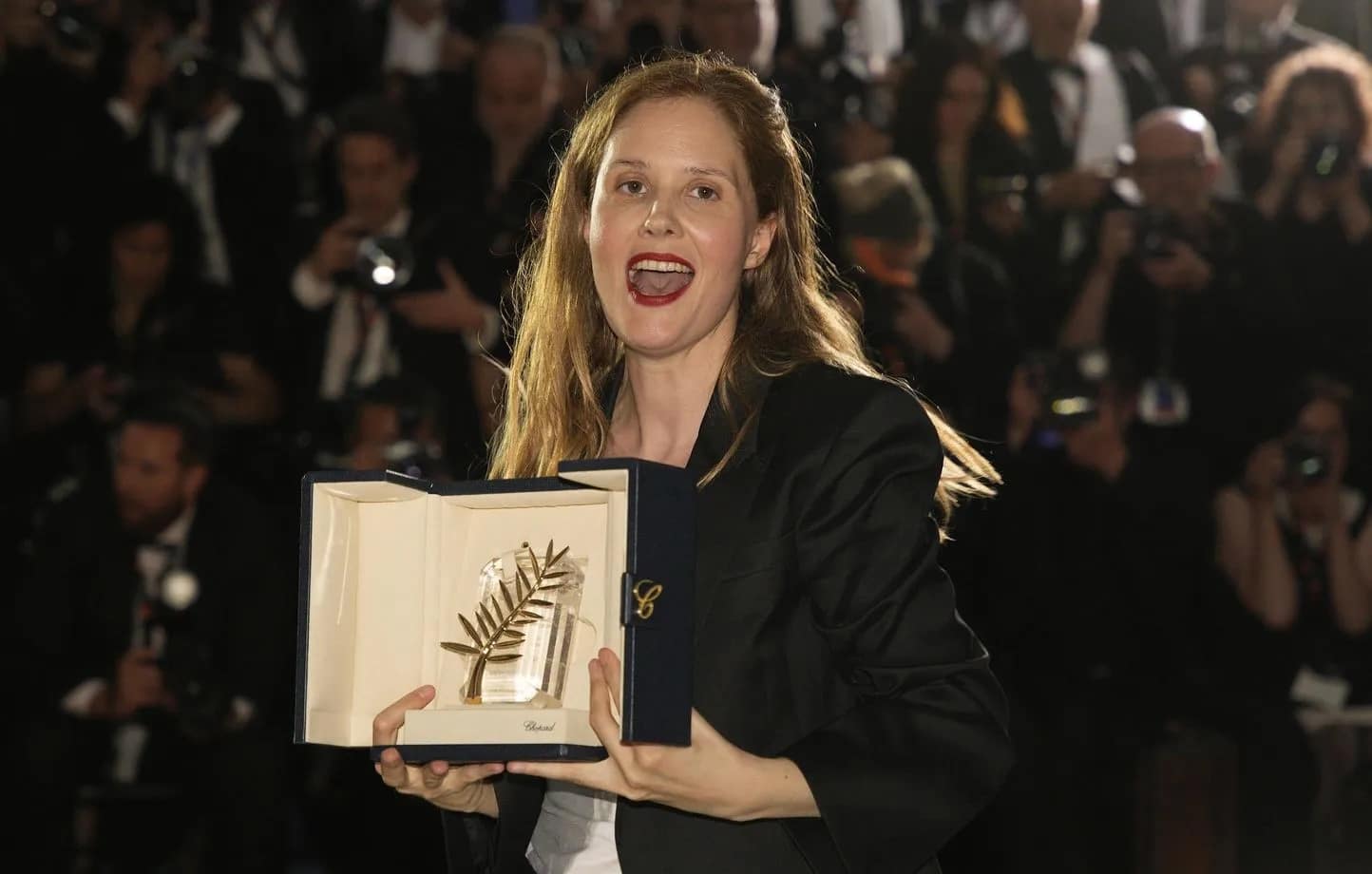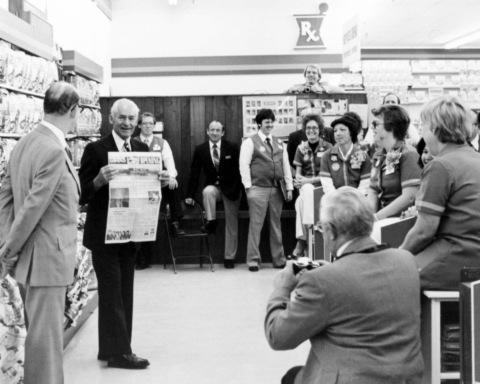Since winning the Palme d’Or, filmmaker Justine Triet’s movie has accumulated numerous international awards. Here are ten reasons that could explain the incredible enthusiasm for ‘Anatomy of a Fall’.
The jury of the 76th Cannes Film Festival can be proud of its choice. Adorned with the Palme d’Or, Justine Triet’s film “Anatomy of a Fall” has received other highly prestigious awards since the beginning of the year: two Golden Globes, a Goya, a Bafta, six César Awards, and several European and American prizes. In total, about thirty awards. The highlight of the awards season, this psychological thriller won the Oscar for Best Original Screenplay co-written by Julie Triet and Arthur Harari, her partner, on March 10th in Hollywood. An unexpected international consecration for this French auteur film with a small budget supported by the CNC’s Advance on Receipts.
The feature film manages the feat of appealing to a wide audience, critics, and cinema professionals. Rare! With a runtime of two and a half hours, it has been seen by 1.6 million viewers in France. It has been bought by 155 countries and has recorded 2 million admissions abroad. A launch that is just beginning.
But why so much enthusiasm for “Anatomy of a Fall”? Curiosity for this French oddity plays a part, but not only. Here are ten reasons that, according to us, could explain its incredible success.
A “winter” event in the mountains
The story resembles a news item that touches the voyeuristic side of the audience.
A couple has settled in a chalet in Savoie, in the Maurienne valley. They must settle the debts they incurred when they lived in London. Sandra is a successful German author. Samuel is a teacher, but he dreams of being a recognized writer. Tensions between them are palpable. They have a visually impaired son, Daniel, who takes long walks in the mountains with Snoop, his guide dog. One day, Samuel is found dead. The bloodied body lies in the snow. He fell from the top of the chalet. Suicide or murder committed by his wife? This chilling question creates suspense. The film’s plot is built around this “winter” event.
A psychological thriller
Justine Triet wrote the script with her partner, Arthur Harari, a screenwriter, actor, director. The couple, she knows! At the Oscar ceremony for Best Original Screenplay, she recounts, “We were at home with our two children. It was during the lockdown, and we put them in front of cartoons on TV to have some peace. There was no separation between work and diaper changes.” The director told the press that these four months of writing were difficult and that she no longer wants to write as a couple. At least, not under the same conditions.
From the start of the film (unless you’ve read reviews), the viewer doesn’t know where the plot will lead. They let themselves be guided into a psychological labyrinth. The film is surgical, efficient. It details with a scalpel the couple’s relationships, Daniel’s isolation, the role of social services, Vincent Renzi’s platonic love, the prosecutor’s stern posture. Gradually, the puzzle takes shape.
A courtroom drama appeals
The title “Anatomy of a Fall” is a nod to “Anatomy of a Murder,” a classic directed in 1959 by Otto Preminger.
Audiences love courtroom dramas: “The Dominici Case,” “Omar Killed Me,” most recently “The Goldman Case” (where Arthur Harari plays the lawyer Georges Kiejman) and many others.
In “Anatomy of a Fall,” two genres juxtapose: the investigative film and the courtroom drama. Some courtroom dramas are slow, verbose, didactic. Julie Triet avoids these pitfalls. Upfront, she presents an intellectual woman, a family life in the mountains, the drama. With the arrival of Vincent Renzi, the lawyer friend who defends her, the film shifts towards the investigation. Sandra is indicted. In court, the reconstruction of events in the form of flashbacks avoids a linear and claustrophobic narrative. These scenes shed new light on the couple’s relationships. They are interspersed with the judge’s questions, the prosecutor’s, and the defense by the accused’s lawyer.
Outdoor shots allow the viewer to breathe the mountain’s fresh air. A platonic romance develops between Sandra and Vincent. Love, always love…
Questioning the truth
There is a verdict at the end of the trial, but does it dispel doubts? How can we bring forth the truth, which rests on partial facts and expert opinions that need interpretation? The conclusion of the case relies mainly on Daniel’s testimony. At the judge’s request, the child no longer speaks to his mother to avoid being influenced. This does not exclude filial love. Daniel confides in Marge, his judicial supervisor, his anxiety about determining what is true. She replies that sometimes, when we don’t know what is truly true, we can simply decide what is true for us.
Did Daniel lie when he said his father had suicidal tendencies? Sandra behind bars, what would have become of him? Isn’t the heroine both innocent and guilty? This film questions us about our relationship with the truth. It also takes an unflinching look at justice, which we can regret for its missteps, reversals, and judicial errors.
A cast supported by contemporary talents
Justine Triet carefully orchestrated her cast with top names in contemporary cinema.
Spotted in 2006 in “Requiem,” Sandra Hüller won the Silver Bear for Best Actress at the Berlinale in Berlin for this role. In 2016, she made an impression in “Toni Erdmann” and won the Best Actress award at the European Film Awards. In 2019, she starred in two French films: Justine Triet’s “Sibyl” and Alice Winocour’s “Proxima.” She is one of the leading figures in European cinema.
“I wrote thinking of her, scared to death, wondering if she would accept,” Justine Triet confided to our late colleague Gilles Kerdreux.
Swann Arlaud, who plays the role of the lawyer, is one of the faces of French auteur cinema. With “Bloody Milk,” he received the César for Best Actor in 2018.
Messi, actors’ and festival-goers’ best friend
Messi at the #Oscars pic.twitter.com/YLQPOivlcn
— Film Updates (@FilmUpdates) March 11, 2024
“Anatomy of a Fall” could it become a must in wildlife cinema? It is an indispensable character in a mountainous setting and alongside a visually impaired child. Snoop, the blue-eyed Border Collie, has the honor of being in the forefront of “Anatomy of a Fall”. Played by Messi, the four-legged companion plays a crucial role. He helps the court reconsider the criminal case in a different light.
Winner of the Palm Dog at the Cannes Film Festival, Messi is praised for his portrayal of certain scenes, including the poisoning scene.
He flew to Los Angeles during the Oscar campaign. Several film distributors competing with the French feature felt his participation wasn’t fair. It could influence the jury’s vote. It goes to show how much people love dogs…
Messi’s presence at the Oscars ceremony quickly went viral on social media. Comfortably seated on a red armchair, he seems to be applauding. But the sequence was actually shot a few hours earlier with fake paws! Messi has become famous, the actors’ and festival-goers’ best friend.
A haunting music like a mantra
At the very beginning of the film, Samuel turns up the volume of the music when his wife receives a young doctoral student at the chalet. She cannot conduct her interview and leaves. The music Samuel listens to at full blast is a cover of the steel drums (Caribbean steel drums) by the Bacao Rhythm & Steel Band, which covers the rapper 50 Cent’s song P.I.M.P. It is haunting, mesmerizing. It returns like an obsessive mantra. It’s a melody that heralds a dramatic arc. It sets the mood of the film.
“My intention was to find fairly cheerful music. I hesitated with classical music, but it made the whole thing too pompous, too Kubrickian, even though I love Kubrick. I had to find something light enough, which contrasts with the situation that comes a few minutes later,” Justine Triet explains on the show “Le Cercle” on Canal+.
A film beyond the #MeToo movement
This feature film goes beyond the #MeToo movement. When Sandra says to her husband, “I don’t know any writer prevented from writing because he has errands to run.” In a man’s mouth, this off-the-cuff remark would be considered terribly misogynistic. In this film, the roles are reversed. The woman is autonomous, powerful. The man is fragile, dependent.
Sandra has a dominant position in the couple. It is she who succeeds, not Samuel. He takes care of Daniel and does “homeschooling”. Sandra is unhappy, she cheats on her husband … with a woman. Her bisexuality adds to the complexity of her character. With all these ingredients, “Anatomy of a Fall” is very contemporary. Without taboo.
A feminist director
Julie Triet, 45, mother of two, embodies a new generation of women directors appreciated by feminists.
With “Anatomy of a Fall,” it is an opportunity for juries to display gender parity in the world of cinema. It is also a way to rebalance awards between small-budget auteur films and Hollywood blockbusters.
The Weinstein affair has left its mark: there is much to be forgiven…
In 79 years of the Cannes Film Festival, Justine Triet is the third woman to receive the Palme d’Or!
She is the first woman to achieve the double of the Palme d’Or and the César for Best Film. Only two films have received this double award: “The Pianist” by Roman Polanski in 2003 and “Amour” by Michael Haneke in 2013.
An intense campaign among voters
#AnatomyofaFall writers Justine Triet and Arthur Harari wins best original screenplay at the 2024 #Oscars pic.twitter.com/MAh8Kk88OR
— The Hollywood Reporter (@THR) March 10, 2024
To hope for an Oscar, Justine Triet, Arthur Harari, and the team of “Anatomy of a Fall” embarked on an intense campaign lasting several months across the Atlantic. Facing giants of American cinema like “Oppenheimer,” “Barbie,” “Killers of Flower Moon,” the “small French film” required intense lobbying to position itself as a serious contender.
Interviews, cocktails, lunches, screenings, gift battles…
It’s the equivalent of an election campaign where one must put aside their private life. The goal is to make the film appreciated among the 10,000 Oscar voters.
Before receiving the Palme d’Or, producer David Thion had the good idea to sign with distributor Neon. “It’s one of the top 3 distributors in the United States, it has expertise and financial backing to campaign,” he explained on France Info.
This whole process surprises the French because it doesn’t exist in our country. “One should not pass moral judgment. The Oscars require media presence if one is not well-known,” comments Laurent Sénéchal, editor of “Anatomy of a Fall.”
Meeting Hollywood’s elite will remain a strong memory for the film’s team. Justine Triet was able to exchange with Steven Spielberg… Result: five nominations and the Oscar for Best Original Screenplay.
“Anatomy of a Fall,” a pure product of French cultural exception, is now the new darling of the public beyond the borders of France. Let’s wish it a long life.
The main Awards of “Anatomy of a Fall”
Palme d’Or at Cannes
Six Césars in Paris
– Best film for Justine Triet
– Best direction for Justine Triet
– Best original screenplay for Justine Triet and Arthur Harrari
– Best actress for Sandra Hüller
– Best supporting actor for Swann Arlaud
– Best editing for Laurent Sénéchal
An Oscar in Hollywood
– Best Original Screenplay
Two Golden Globes in Beverly Hills
– Best Foreign Language Film
– Best Screenplay
A Bafta in London
– Best Original Screenplay
A Goya in Valladolid
– Best European Film
Three European Film Awards
– Best Film
– Best Direction
– Best Actress
Read also>BARBIE DIRECTOR GRETA GERWIG TO HEAD CANNES 2024 JURY
Featured photo : ©AP/SIPA
















